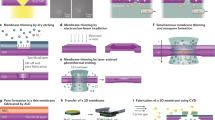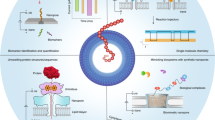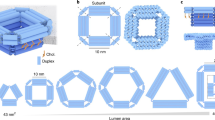Abstract
Solid-state nanopores are now well established as single-biomolecule sensors that hold great promise as sensing elements in diagnostic and sequencing applications. However, until recently this promise has been limited by the expensive, labor-intensive, and low-yield methods used to fabricate low-noise and precisely sized pores. To address this problem, we pioneered a low-cost and scalable solid-state nanopore fabrication method, termed controlled breakdown (CBD), which is rapidly becoming the method of choice for fabricating solid-state nanopores. Since its initial development, nanopore research groups around the world have applied and adapted the CBD method in a variety of ways, with varying levels of success. In this work, we present our accumulated knowledge of nanopore fabrication by CBD, including a detailed description of the instrumentation, software, and procedures required to reliably fabricate low-noise and precisely sized solid-state nanopores with a yield of >85% in less than 1 h. The assembly instructions for the various custom instruments can be found in the Supplementary Manual, and take approximately a day to complete, depending on the unit that the user is building and their level of skill with mechanical and electrical assembly. Unlike traditional beam-based nanopore fabrication technologies, the methods presented here are accessible to non-experts, lowering the cost of, and technical barriers to, fabricating nanoscale pores in thin solid-state membranes.
This is a preview of subscription content, access via your institution
Access options
Access Nature and 54 other Nature Portfolio journals
Get Nature+, our best-value online-access subscription
$29.99 / 30 days
cancel any time
Subscribe to this journal
Receive 12 print issues and online access
$259.00 per year
only $21.58 per issue
Buy this article
- Purchase on Springer Link
- Instant access to full article PDF
Prices may be subject to local taxes which are calculated during checkout









Similar content being viewed by others
Data availability
Data for all graphs is available from the corresponding author upon reasonable request.
Code availability
An executable version of the custom software presented (CBD Soft) is freely available for non-commercial uses, as outlined in the End-User License Agreement in the installer.
References
Yusko, E. C. et al. Real-time shape approximation and fingerprinting of single proteins using a nanopore. Nat. Nanotechnol. 12, 360–367 (2017).
Briggs, K., Kwok, H. & Tabard-Cossa, V. Automated fabrication of 2-nm solid-state nanopores for nucleic acid analysis. Small 10, 2077–2086 (2014).
Wanunu, M. Nanopores: a journey towards DNA sequencing. Phys. Life Rev. 9, 125–158 (2012).
Brown, C. G. & Clarke, J. Nanopore development at oxford nanopore. Nat. Biotechnol. 34, 810 (2016).
Morin, T. J. et al. A handheld platform for target protein detection and quantification using disposable nanopore strips. Sci. Rep. 8, 1–12 (2018).
Quick, J. et al. Real-time, portable genome sequencing for ebola surveillance. Nature 530, 228–232 (2016).
Derrington, I. M. et al. Nanopore DNA sequencing with MspA. Proc. Natl Acad. Sci. USA 107, 16060–5 (2010).
Loman, N. J., Quick, J. & Simpson, J. T. A complete bacterial genome assembled de novo using only nanopore sequencing data. Nat. Methods 12, 733–735 (2015).
Szalay, T. & Golovchenko, J. A. De novo sequencing and variant calling with nanopores using PoreSeq. Nat. Biotechnol. 33, 1087–1091 (2015).
Jain, M. et al. Improved data analysis for the MinION nanopore sequencer. Nat. Methods 12, 351–356 (2015).
Branton, D. et al. The potential and challenges of nanopore sequencing. Nat. Biotechnol. 26, 1146–1153 (2008).
Bayley, H. Nanopore sequencing: from imagination to reality. Clin. Chem. 61, 25–31 (2015).
Manrao, E. A. et al. Reading DNA at single-nucleotide resolution with a mutant MspA nanopore and phi29 DNA polymerase. Nat. Biotechnol. 30, 349–53 (2012).
Cherf, G. M. et al. Automated forward and reverse ratcheting of DNA in a nanopore at 5-Å precision. Nat. Biotechnol. 30, 344–8 (2012).
Bayley, H. Getting to the bottom of the well. Nat. Nanotechnol. 12, 1116 (2017).
Galenkamp, N. S., Soskine, M., Hermans, J., Wloka, C. & Maglia, G. Direct electrical quantification of glucose and asparagine from bodily fluids using nanopores. Nat. Commun. 9, 1–8 (2018).
Rodriguez-Larrea, D. & Bayley, H. Multistep protein unfolding during nanopore translocation. Nat. Nanotechnol. 8, 288–295 (2013).
Benner, S. et al. Sequence-specific detection of individual DNA polymerase complexes in real time using a nanopore. Nat. Nanotechnol. 2, 718–724 (2007).
Nivala, J., Marks, D. B. & Akeson, M. Unfoldase-mediated protein translocation through an α-hemolysin nanopore. Nat. Biotechnol. 31, 247–250 (2013).
Nivala, J., Mulroney, L., Li, G., Schreiber, J. & Akeson, M. Discrimination among protein variants using an unfoldase-coupled nanopore. ACS Nano 8, 12365–12375 (2014).
Wallace, E. V. B. et al. Identification of epigenetic DNA modifications with a protein nanopore. Chem. Commun. 46, 8195–8197 (2010).
Howorka, S. & Siwy, Z. S. Nanopores as protein sensors. Nat. Biotechnol. 30, 506–507 (2012).
Briggs, K. et al. DNA translocations through nanopores under nanoscale preconfinement. Nano Lett. 18, 660–668 (2018).
Bell, N. A. W., Chen, K., Ghosal, S., Ricci, M. & Keyser, U. F. Asymmetric dynamics of DNA entering and exiting a strongly confining nanopore. Nat. Commun. 8, 380 (2017).
Morin, T. J. et al. Nanopore-based target sequence detection. PLoS ONE 11, e0154426 (2016).
Atas, E., Singer, A. & Meller, A. DNA sequencing and bar-coding using solid-state nanopores. Electrophoresis 33, 3437–3447 (2012).
Beamish, E., Tabard-cossa, V. & Godin, M. Identifying structure in short DNA scaffolds using solid-state nanopores. ACS Sens. 2, 1814–1820 (2017).
Kong, J., Bell, N. A. W. & Keyser, U. F. Quantifying nanomolar protein concentrations using designed DNA carriers and solid-state nanopores. Nano Lett. 16, 3557–3562 (2016).
Singer, A. et al. Nanopore based sequence specific detection of duplex DNA for genomic profiling. Nano Lett. 10, 738–742 (2010).
Tabard-cossa, V. et al. Single-molecule bonds characterized by solid-state nanopore force spectroscopy. ACS Nano 3, 3009–3014 (2009).
Karau, P. & Tabard-cossa, V. Capture and translocation characteristics of short branched DNA labels in solid-state nanopores. ACS Sens. 3, 1308–1315 (2018).
Alibakhshi, M. A. et al. Picomolar fingerprinting of nucleic acid nanoparticles using solid-state nanopores. ACS Nano 11, 9701–9710 (2017).
Bell, N. A. W. & Keyser, U. F. Digitally encoded DNA nanostructures for multiplexed, single-molecule protein sensing with nanopores. Nat. Nanotechnol. 11, 1–28 (2016).
Kowalczyk, S. W. et al. Single-molecule transport across an individual biomimetic nuclear pore complex. Nat. Nanotechnol. 6, 433–438 (2011).
Karawdeniya, B. I., Bandara, Y. M. N. D. Y., Nichols, J. W., Chevalier, R. B. & Dwyer, J. R. Surveying silicon nitride nanopores for glycomics and heparin quality assurance. Nat. Commun. 9, 1–8 (2018).
Deamer, D., Akeson, M. & Branton, D. Three decades of nanopore sequencing. Nat. Biotechnol. 34, 518–524 (2016).
Wu, M. Y., Krapf, D., Zandbergen, M., Zandbergen, H. & Batson, P. E. Formation of nanopores in a SiN/SiO2 membrane with an electron beam. Appl. Phys. Lett. 87, 1–4 (2005).
Kwok, H., Briggs, K. & Tabard-Cossa, V. Nanopore fabrication by controlled dielectric breakdown. PLoS ONE 9, e92880 (2014).
Briggs, K. et al. Kinetics of nanopore fabrication during controlled breakdown of dielectric membranes in solution. Nanotechnology 26, 084004 (2015).
Pud, S. et al. Self-aligned plasmonic nanopores by optically controlled dielectric breakdown. Nano Lett. 15, 7112–7117 (2015).
Tahvildari, R., Beamish, E., Tabard-Cossa, V. & Godin, M. Integrating nanopore sensors within microfluidic channel arrays using controlled breakdown. Lab Chip 15, 1407–1411 (2015).
Gilboa, T., Zrehen, A., Girsault, A. & Meller, A. Optically-monitored nanopore fabrication using a focused laser beam. Sci. Rep. 8, 9765 (2018).
Goto, Y., Yanagi, I., Matsui, K., Yokoi, T. & Takeda, K. Integrated solid-state nanopore platform for nanopore fabrication via dielectric breakdown, DNA-speed deceleration and noise reduction. Sci. Rep. 6, 31324 (2016).
Yanagi, I., Fujisaki, K., Hamamura, H. & Takeda, K. I. Thickness-dependent dielectric breakdown and nanopore creation on sub-10-nm-thick SiN membranes in solution. J. Appl. Phys. 121, 045301 (2017).
Wang, Y., Chen, Q., Deng, T. & Liu, Z. Nanopore fabricated in pyramidal HfO2 film by dielectric breakdown method. Appl. Phys. Lett. 111, 143103 (2017).
Feng, J. et al. Electrochemical reaction in single layer MoS2: Nanopores opened atom by atom. Nano Lett. 15, 3431–3438 (2015).
Kuan, A. T., Lu, B., Xie, P., Szalay, T. & Golovchenko, J. A. Electrical pulse fabrication of graphene nanopores in electrolyte solution. Appl. Phys. Lett. 106, 203109 (2015).
Bandara, Y. M. N. D. Y., Karawdeniya, B. I. & Dwyer, J. R. Push-button method to create nanopores using a tesla-coil lighter. ACS Omega 4, 226–230 (2019).
Yamazaki, H., Hu, R., Zhao, Q. & Wanunu, M. Photothermally assisted thinning of silicon nitride membranes for ultrathin asymmetric nanopores. ACS Nano 12, 12472–12481 (2018).
Arcadia, C. E., Reyes, C. C. & Rosenstein, J. K. In situ nanopore fabrication and single-molecule sensing with microscale liquid contacts. ACS Nano 11, 4907–4915 (2017).
Kwok, H., Waugh, M., Bustamante, J., Briggs, K. & Tabard-Cossa, V. Long passage times of short ssDNA molecules through metallized nanopores fabricated by controlled breakdown. Adv. Funct. Mater. 24, 7745–7753 (2014).
Tahvildari, R. et al. Manipulating electrical and fluidic access in integrated nanopore-microfluidic arrays using microvalves. Small 13, 1–7 (2017).
Lam, M. H. et al. Entropic trapping of DNA with a nano filtered nanopore. ACS Appl. Nano Mater. 2, 4773–4781 (2019).
Madejski, G. R. et al. Monolithic fabrication of NPN / SiN x dual membrane cavity for nanopore-based DNA sensing. Adv. Mater. Interfaces 6, 1900684 (2019).
Ying, C. et al. Formation of single nanopores with diameters of 20–50 nm in silicon nitride membranes using laser-assisted controlled breakdown. ACS Nano 12, 11458–11470 (2018).
Carlsen, A. T., Briggs, K., Hall, A. R. & Tabard-Cossa, V. Solid-state nanopore localization by controlled breakdown of selectively thinned membranes. Nanotechnology 28, 085304 (2017).
Wang, Y. et al. Fabrication of multiple nanopores in a SiNx membrane via controlled breakdown. Sci. Rep. 8, 1–9 (2018).
Zhang, Y. et al. Nanopore formation via tip-controlled local breakdown using an atomic force microscope. Small Methods 3, 1900147 (2019).
Abe, K. et al. The T2K experiment. Nucl. Instrum. Meth. 659, 106–135 (2011).
Venkatesan, B. M. et al. Highly sensitive, mechanically stable nanopore sensors for DNA analysis. Adv. Mater. 21, 2771–2776 (2009).
Larkin, J. et al. Slow DNA transport through nanopores in hafnium oxide membranes. ACS Nano 7, 10121–8 (2013).
Russo, C. J. & Golovchenko, J. A. Atom-by-atom nucleation and growth of graphene nanopores. Proc. Natl Acad. Sci. USA 109, 5953–5957 (2012).
Liu, K., Feng, J., Kis, A. & Radenovic, A. Atomically thin molybdenum disulfide nanopores with high sensitivity for DNA translocation. ACS Nano 8, 2504–2511 (2014).
Wu, M. et al. Control of shape and material composition of solid-state nanopores. Nano Lett. 9, 479–484 (2009).
Li, J. et al. Ion-beam sculpting at nanometre length scales. Nature 412, 166–169 (2001).
Deng, Y. et al. Precise fabrication of a 5 nm graphene nanopore with a helium ion microscope for biomolecule detection. Nanotechnology 28, 045302 (2017).
Hemamouche, A. et al. FIB patterning of dielectric, metallized and graphene membranes: a comparative study. Microelectron. Eng. 121, 87–91 (2014).
Zahid, O. K. & Hall, A. R. in Helium Ion Microscope Fabrication of Solid-State Nanopore Devices for Biomolecule Analysis. 447–470. Hlawacek G., Gölzhäuser A. (eds). Helium Ion Microscopy. NanoScience and Technology (Springer International Publishing, 2016). https://doi.org/10.1007/978-3-319-41990-9_18
Yang, J. et al. Rapid and precise scanning helium ion microscope milling of solid-state nanopores for biomolecule detection. Nanotechnology 22, 285310 (2011).
Emmrich, D. et al. Nanopore fabrication and characterization by helium ion microscopy. Appl. Phys. Lett. 108, 163103 (2016).
Yanagi, I., Akahori, R., Hatano, T. & Takeda, K. Fabricating nanopores with diameters of sub-1 nm to 3 nm using multilevel pulse-voltage injection. Sci. Rep. 4, 5000 (2014).
Bustamante, J. Synchronous Optical and Electrical Measurements of Single DNA Molecules Translocating Through a Solid-State Nanopore. MSc thesis, Univ. Ottawa (2014).
Briggs, K. Solid-State Nanopores: Fabrication, Application, and Analysis. PhD thesis, Univ. Ottawa (2018).
Tabard-Cossa, V., Trivedi, D., Wiggin, M., Jetha, N. N. & Marziali, A. Noise analysis and reduction in solid-state nanopores. Nanotechnology 18, 305505 (2007).
Kowalczyk, S. W., Grosberg, A. Y., Rabin, Y. & Dekker, C. Modeling the conductance and DNA blockade of solid-state nanopores. Nanotechnology 22, 315101 (2011).
Beamish, E., Kwok, H., Tabard-Cossa, V. & Godin, M. Precise control of the size and noise of solid-state nanopores using high electric fields. Nanotechnology 23, 405301 (2012).
Wen, C., Zhang, Z. & Zhang, S. L. Physical model for rapid and accurate determination of nanopore size via conductance measurement. ACS Sens. 2, 1523–1530 (2017).
Frament, C. M., Bandara, N. & Dwyer, J. R. Nanopore surface coating delivers nanopore size and shape through conductance-based sizing. ACS Appl. Mater. Interfaces 5, 9330–9337 (2013).
Frament, C. M. & Dwyer, J. R. Conductance-based determination of solid-state nanopore size and shape: an exploration of performance limits. J. Phys. Chem. C. 116, 23315–23321 (2012).
Fragasso, A., Pud, S. & Dekker, C. 1/f noise in solid-state nanopores is governed by access and surface regions. Nanotechnology 30, 395202 (2019).
Acknowledgements
We would like to acknowledge financial support from the Natural Sciences and Engineering Research Council of Canada (NSERC) i2i and CRD, as well as Ontario Centres of Excellence (OCE) VIP II grant programs. K.B. acknowledges the support of the Vanier Canadian Graduate Scholarship program. The authors would like to thank all members of the Tabard-Cossa and Godin laboratories at the University of Ottawa for their help in testing and troubleshooting the hardware, software, and protocols presented in this work.
Author information
Authors and Affiliations
Contributions
K.B. and V.T.-C. developed the CBD method. K.B. and M.W. designed the software protocols. M.G. wrote the LabView code of the software. D.G., M.W., S.K., Q.I., A.M.J., S.B., D.L., and L.A. designed and built the hardware. M.W. and K.B. developed the particular protocols provided. M.W., K.B., and V.T.-C. wrote the manuscript.
Corresponding author
Ethics declarations
Competing interests
V.T.-C. and K.B. hold several patents related to CBD. All other authors have no competing interests.
Additional information
Peer review information Nature Protocols thanks Sébastien Balme and Ralph Scheicher for their contribution to the peer review of this work.
Publisher’s note Springer Nature remains neutral with regard to jurisdictional claims in published maps and institutional affiliations.
Supplementary information
Supplementary Manual
Component lists, assembly instructions, circuit diagrams and enlarged screenshots of our custom software
Supplementary Note 1
Detailed CAD designs and technical drawings
Supplementary Note 2
The PCB layout, in NI Ultiboard file format
Supplementary Software
An executable version of the custom software presented (CBD Soft). Updated versions will be available on our lab’s website (www.tcossalab.net/cbd)
Rights and permissions
About this article
Cite this article
Waugh, M., Briggs, K., Gunn, D. et al. Solid-state nanopore fabrication by automated controlled breakdown. Nat Protoc 15, 122–143 (2020). https://doi.org/10.1038/s41596-019-0255-2
Received:
Accepted:
Published:
Issue Date:
DOI: https://doi.org/10.1038/s41596-019-0255-2
This article is cited by
-
Study on the controllability of the fabrication of single-crystal silicon nanopores/nanoslits with a fast-stop ionic current-monitored TSWE method
Microsystems & Nanoengineering (2023)
-
Nanopore-based technologies beyond DNA sequencing
Nature Nanotechnology (2022)
-
Elucidating the dynamics of polymer transport through nanopores using asymmetric salt concentrations
Nano Research (2022)
-
Localised solid-state nanopore fabrication via controlled breakdown using on-chip electrodes
Nano Research (2022)
-
Digital immunoassay for biomarker concentration quantification using solid-state nanopores
Nature Communications (2021)
Comments
By submitting a comment you agree to abide by our Terms and Community Guidelines. If you find something abusive or that does not comply with our terms or guidelines please flag it as inappropriate.



